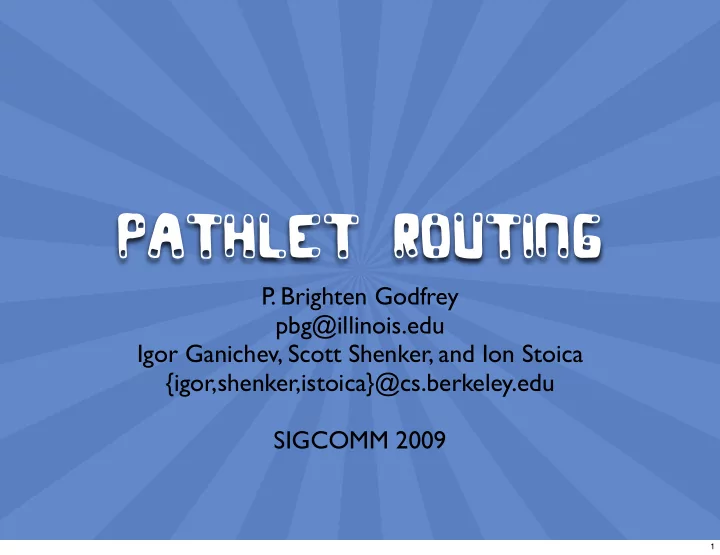

Pathlet Routing P. Brighten Godfrey pbg@illinois.edu Igor Ganichev, Scott Shenker, and Ion Stoica {igor,shenker,istoica}@cs.berkeley.edu SIGCOMM 2009 1
Design for variation “ Design for variation in outcome, so that the outcome can be different in different places, and the tussle takes place within the design, not by ” distorting or violating it. –– Clark, Wroclawski, Sollins & Braden, 2002 “Tussle in Cyberspace” 2
High level goals • Goal: flexibility in network services • “Route to this destination”, route along a specified path, VPNs, quality of service, ... • Goal: user choice • Reliability, path quality, throughput, promote competition, ... 3
Pathlet routing’s solution • Goal: flexibility in network services • Represent network as a virtual topology vnode virtual node pathlet fragment of a path: a sequence of vnodes • Goal: User choice • Source routing within virtual topology 4
Outline • The protocol • Uses • Experimental results • Comparing routing protocols 5
Pathlet routing vnode virtual node pathlet fragment of a path: a sequence of vnodes Source routing over pathlets. 6
vnodes vnode: virtual node within an AS Walla Walla New York Crumstown San Diego Roosterville 7
vnodes vnode: virtual node within an AS designated ingress vnode for each neighbor Internally: a forwarding table at one or more router router routers router 8
Pathlets Packet route field Forwarding table ... ... A 3 3 3 push 7,2; fwd to B ... ... B 7,2 7 fwd to C 7 ... ... C 2 2 fwd to D 2 D delivered! 9
Dissemination • Global gossip fine, except for scalability • So, let routers choose not to disseminate some pathlets • Leads to (ironic) use of path vector –– only for pathlet dissemination, not route selection 10
Outline • The protocol • Uses • Experimental results • Comparing routing protocols 11
Local transit policies Each ingress egress pair is either allowed or disallowed. Subject to this, any path allowed! Represented with few pathlets: small FIB 12
“All valley-free” is local provider provider “customers ingress from can route to egress to a provider a provider anyone; anyone can ingress from egress to route to a customer a customer customers” customer customer Forwarding table size: 3 + #neighbors 13
Choice for senders Local transit policies provide some policy control for networks, while enabling a large number of paths for senders. source destination 14
Emulating BGP 128.2.0.0/16 15
Mixed policies local BGP-like local local local 16
Emulating NIRA Tricky bit: policy can depend on previous hops! 17
Emulating NIRA A NIRA: carry state about previous hops in destination IP address. B C AB Pathlets: carry state about previous hops in D E vnode. ABD ACD ABDF ACEF F ACDF 18
Outline • The protocol • Uses • Experimental results • Comparing routing protocols 19
Improved connectivity BGP-style Mixed LT policies 20
Tiny forwarding tables current Internet Forwarding table size CDF (CAIDA/APNIC): BGP 132,158+ entries: one per IP prefix pathlet routing, 2,264 entries, max valley-free 8.48 entries, mean LT policies 21
Control overhead 2.23x more messages, 1.61x more memory in LT than PV This can likely be improved. 22
Questions • Are either of these protocols viable? • Would ASes actually use “local” policies (permitting many routes) or would they stick with BGP-style? • Are there security vulnerabilities in NIRA or PR that are not in the current Internet? 23
Recommend
More recommend